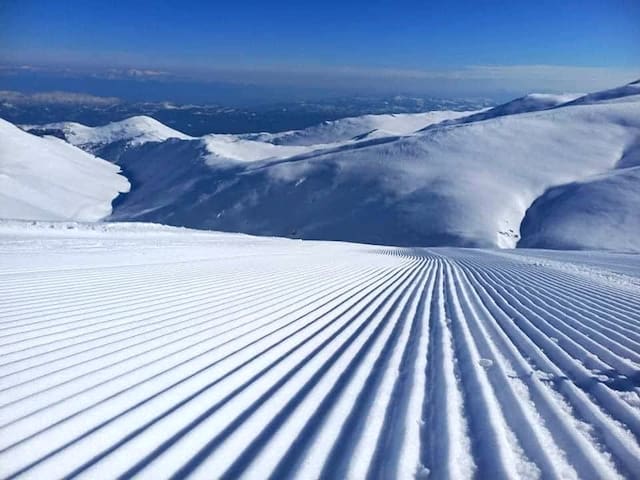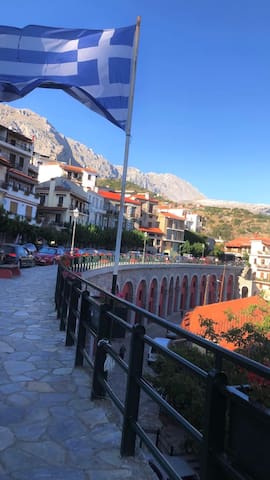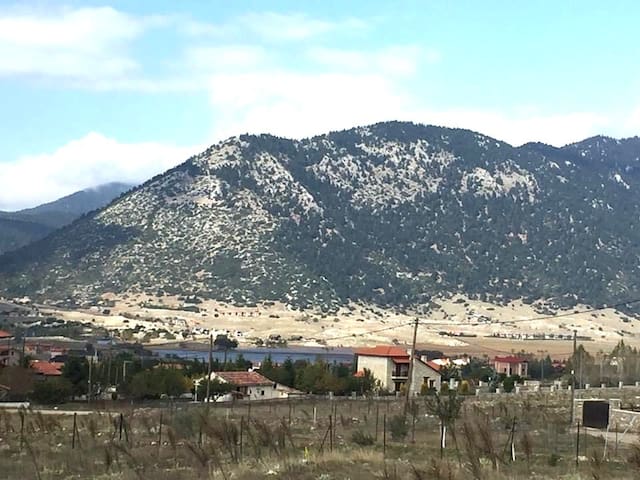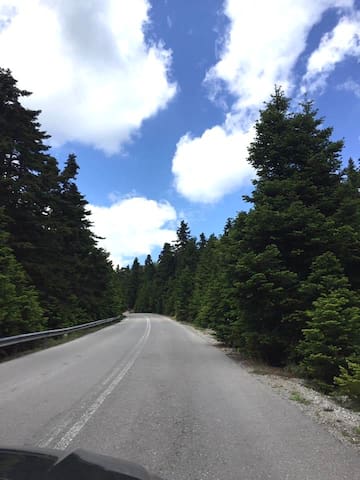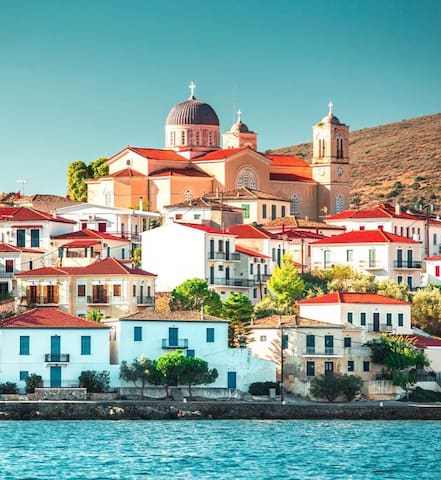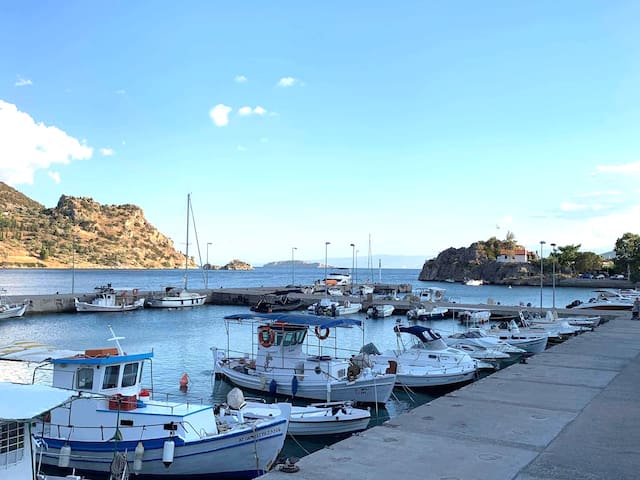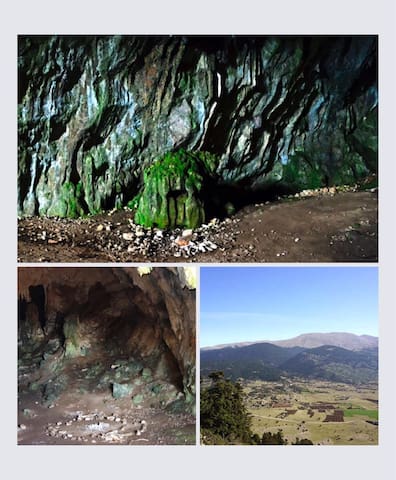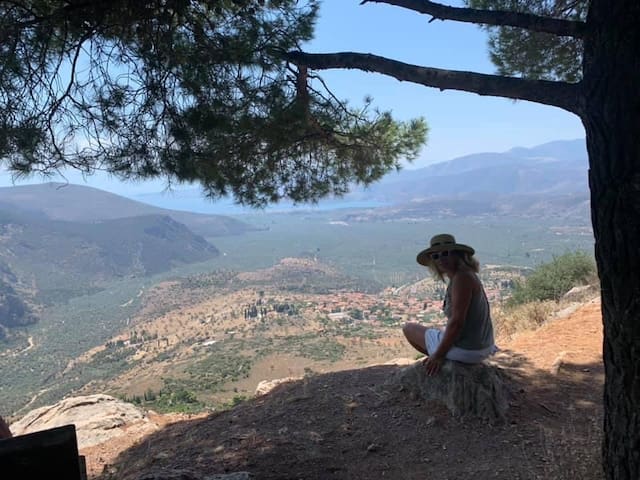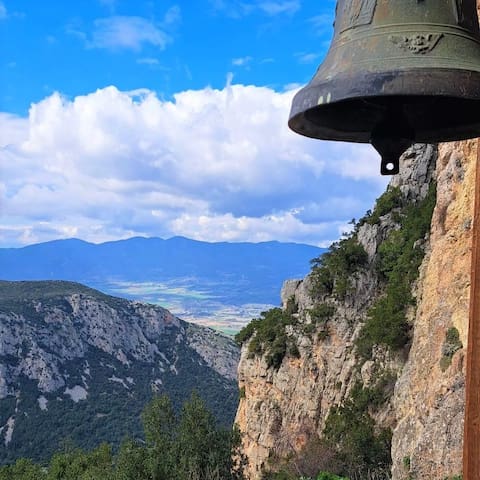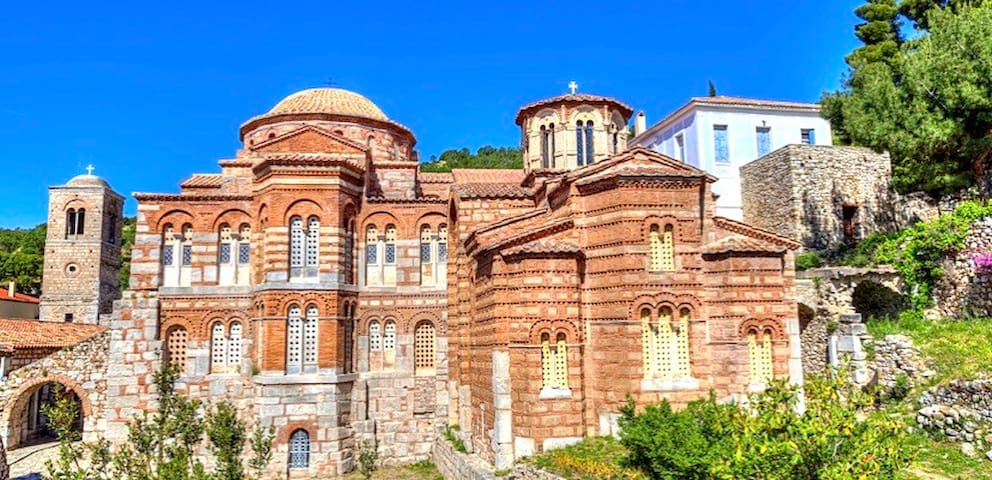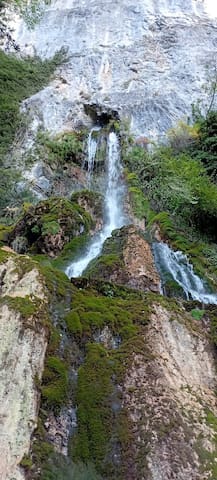Winter Activities
Parnassus ski centre
With the new state-of-the-art detachable lifts in Kelaria and Fterolaka, Parnassos Ski Center is now on the list of top ski resorts in the Balkans.
In 2014, the first phase of its modernization took place, which concerned the Cellars. The new state-of-the-art Combi lift named "Aphrodite - Bacchus" includes the detachable lift with 8-seater cabins (8 MGD) "Aphrodite" and the detachable lift with 6-seater chairs and 8-seater cabins "Bacchus".
The two elevators connect to the intermediate station at Cellars and are designed to operate in combination or independently.
In many parts of the ski area there is visual contact with the Corinthian Gulf, as well as the Euboean Gulf. The possibility of skiing with a view of the Greek seas, soars the skiing experience to the heights.
In the Parnassos Ski Center there are two ski areas, Kelaria and Fterolaka, which have a total of:
21 tracks and 7 ski routes
5 connecting paths
4 mini tracks for beginners with babylifts with a total length of 34 km
The descents start from 2260m. and reach up to 1640 m. altitude, while their length varies between 300m. and 4 km. Powder funs will find plenty of off-piste routes for freeride. There are also 2 Snow Fun parks in Kellaria and Fterolaka. Four of the slopes, No. 6 Hiniochos, No. 8 Herakles, No. 9 Odysseus and No. 2 Bacchos, are certified by the International Ski Federation (F.I.S. Homologation) for the organization of international ski competitions.
51 místní doporučují
Parnassos Ski Centre
With the new state-of-the-art detachable lifts in Kelaria and Fterolaka, Parnassos Ski Center is now on the list of top ski resorts in the Balkans.
In 2014, the first phase of its modernization took place, which concerned the Cellars. The new state-of-the-art Combi lift named "Aphrodite - Bacchus" includes the detachable lift with 8-seater cabins (8 MGD) "Aphrodite" and the detachable lift with 6-seater chairs and 8-seater cabins "Bacchus".
The two elevators connect to the intermediate station at Cellars and are designed to operate in combination or independently.
In many parts of the ski area there is visual contact with the Corinthian Gulf, as well as the Euboean Gulf. The possibility of skiing with a view of the Greek seas, soars the skiing experience to the heights.
In the Parnassos Ski Center there are two ski areas, Kelaria and Fterolaka, which have a total of:
21 tracks and 7 ski routes
5 connecting paths
4 mini tracks for beginners with babylifts with a total length of 34 km
The descents start from 2260m. and reach up to 1640 m. altitude, while their length varies between 300m. and 4 km. Powder funs will find plenty of off-piste routes for freeride. There are also 2 Snow Fun parks in Kellaria and Fterolaka. Four of the slopes, No. 6 Hiniochos, No. 8 Herakles, No. 9 Odysseus and No. 2 Bacchos, are certified by the International Ski Federation (F.I.S. Homologation) for the organization of international ski competitions.
Nearby Places
Whether you choose a romantic stroll along its picturesque cobbled streets, or a stroll down its busy main street, a stroll through Arachova reveals the charming marriage of the old and the new. All this, in the holy lands of Parnassos, the mountain of Apollo.
Arachova is undoubtedly the princess of Parnassos. Built amphitheatrically, it spreads out majestically on the southern slopes of the mountain to end up in a ravine where the river Pleistos flows. Its central square is located at an altitude of 960 meters.
Administratively it belongs to the prefecture of Viotia and the Municipality of Distomo-Arachova-Antikyra.
The wild beauty of Arachova combined with its unchanged traditional character, its cosmopolitan face and the numerous activities offered by the enchanting Parnassos, rightfully rank it at the top of Greek winter tourism and on the list of top destinations for the rest of the seasons as well.
What to do in Arachova - Activities
* Skiing and snowboarding at Parnassos Ski Center With 21 pistes and 7 routes totaling 36km in the Kelaria and Fterolakka areas, Parnassos is the largest and best ski resort in Greece, as well as a highly competitive skiing option in the Balkans.
* Hiking: A branch of Trekking Hellas operates in Arachova, which you can trust for organized hikes on the paths of Parnassos.
* Horseback riding: Horseback riding in Arachova is one of the top activities offered on the mountain. In Livadi there is an area for equestrian activities, called "Ati".
* Mountain biking on the wonderful trails of the Parnassos National Forest: Organized tours, mountain bike lessons and bike rentals are offered by the True Wheels team in Livadi.
* Snow mobile ride: One of the most beautiful spots where snow mobiles are rented is Dokano (location that connects Livadi with Eptalofos).
* Organized tours with ATV and Buggy: One of the best ways to get to know the wild nature of Arachova, is the ride with... a pig. In Livadi during the winter months, the base of Polaris Parnassos Experience operates for organized tours.
* Snowshoeing: Walking in the snow becomes an easy task with the use of snowshoes on the shoes. You will find snowshoes at the Snow Republic store in Arachova.
* What is worth seeing in Arachova - Sights
* Lakka Square: The absolute hot spot of Arachova could only be its cobbled central square, with dozens of shops and wonderful decorations.
* Ai Giorgis: It is worth the effort to climb the 264 steps (Egarsios) that start from the main road, to find yourself in the Holy Church of Agios Georgios, where you will admire the wonderful view. In honor of Ai George, the well-known Arachova Festival is held every year.
* The Clock of Arachova: A trademark of Arachova is the steep rock with the clock, which dates from the beginning of the 18th century. The rock on which it was built served as a natural refrigerator for storage
* Next to the clock rock, is the Holy Church of the Entry of the Virgin and the old Primary School which today functions as the Folklore Museum of Arachova.
* The picturesque alleys: As a mountain village of Roumeli, Arachova keeps its traditional character and architecture unchanged. A hallmark of tradition are its beautiful cobbled cobblestones, which are located around its main street and will reward those who slip away from its intense traffic.
Food in Arachova - Local gastronomy
In the taverns and restaurants of Arachova you can taste local meats such as the famous mutton kontosovli and kokoretsi, lamb or goat in greaseproof paper, village pies, traditional appetizers and sarmades from the goats of Parnassos, handmade noodles and trachanas.
In all taverns and restaurants you will find the infamous Arachovite cheese, formella, in various versions. Formala has a designation of origin registered by the European Union.
Accompany your meal with the famous brusko Arachovite wine and complete your meal by enjoying local yogurt with honey or traditional Arachovite sweets and spoon sweets.
Fun in Arachova - The "Mykonos of Winter"
The entertainment in Arachova needs no introduction. With a lively nightlife, the cosmopolitan village of Parnassos has rightly earned its reputation as a top winter destination for entertainment and the title "Mykonos of Winter".
All day cafe-bars, party restaurants, mountain cafe-bars as well as nightclubs that keep the fun going until morning. The options in Arachova are endless for all tastes and preferences.
Traditional products of Arachova
Among the well-known local products produced by Arachova are Arachovite textiles, the famous traditional local cheese "Formaela of Arachova"
64 místní doporučují
Arachova
Whether you choose a romantic stroll along its picturesque cobbled streets, or a stroll down its busy main street, a stroll through Arachova reveals the charming marriage of the old and the new. All this, in the holy lands of Parnassos, the mountain of Apollo.
Arachova is undoubtedly the princess of Parnassos. Built amphitheatrically, it spreads out majestically on the southern slopes of the mountain to end up in a ravine where the river Pleistos flows. Its central square is located at an altitude of 960 meters.
Administratively it belongs to the prefecture of Viotia and the Municipality of Distomo-Arachova-Antikyra.
The wild beauty of Arachova combined with its unchanged traditional character, its cosmopolitan face and the numerous activities offered by the enchanting Parnassos, rightfully rank it at the top of Greek winter tourism and on the list of top destinations for the rest of the seasons as well.
What to do in Arachova - Activities
* Skiing and snowboarding at Parnassos Ski Center With 21 pistes and 7 routes totaling 36km in the Kelaria and Fterolakka areas, Parnassos is the largest and best ski resort in Greece, as well as a highly competitive skiing option in the Balkans.
* Hiking: A branch of Trekking Hellas operates in Arachova, which you can trust for organized hikes on the paths of Parnassos.
* Horseback riding: Horseback riding in Arachova is one of the top activities offered on the mountain. In Livadi there is an area for equestrian activities, called "Ati".
* Mountain biking on the wonderful trails of the Parnassos National Forest: Organized tours, mountain bike lessons and bike rentals are offered by the True Wheels team in Livadi.
* Snow mobile ride: One of the most beautiful spots where snow mobiles are rented is Dokano (location that connects Livadi with Eptalofos).
* Organized tours with ATV and Buggy: One of the best ways to get to know the wild nature of Arachova, is the ride with... a pig. In Livadi during the winter months, the base of Polaris Parnassos Experience operates for organized tours.
* Snowshoeing: Walking in the snow becomes an easy task with the use of snowshoes on the shoes. You will find snowshoes at the Snow Republic store in Arachova.
* What is worth seeing in Arachova - Sights
* Lakka Square: The absolute hot spot of Arachova could only be its cobbled central square, with dozens of shops and wonderful decorations.
* Ai Giorgis: It is worth the effort to climb the 264 steps (Egarsios) that start from the main road, to find yourself in the Holy Church of Agios Georgios, where you will admire the wonderful view. In honor of Ai George, the well-known Arachova Festival is held every year.
* The Clock of Arachova: A trademark of Arachova is the steep rock with the clock, which dates from the beginning of the 18th century. The rock on which it was built served as a natural refrigerator for storage
* Next to the clock rock, is the Holy Church of the Entry of the Virgin and the old Primary School which today functions as the Folklore Museum of Arachova.
* The picturesque alleys: As a mountain village of Roumeli, Arachova keeps its traditional character and architecture unchanged. A hallmark of tradition are its beautiful cobbled cobblestones, which are located around its main street and will reward those who slip away from its intense traffic.
Food in Arachova - Local gastronomy
In the taverns and restaurants of Arachova you can taste local meats such as the famous mutton kontosovli and kokoretsi, lamb or goat in greaseproof paper, village pies, traditional appetizers and sarmades from the goats of Parnassos, handmade noodles and trachanas.
In all taverns and restaurants you will find the infamous Arachovite cheese, formella, in various versions. Formala has a designation of origin registered by the European Union.
Accompany your meal with the famous brusko Arachovite wine and complete your meal by enjoying local yogurt with honey or traditional Arachovite sweets and spoon sweets.
Fun in Arachova - The "Mykonos of Winter"
The entertainment in Arachova needs no introduction. With a lively nightlife, the cosmopolitan village of Parnassos has rightly earned its reputation as a top winter destination for entertainment and the title "Mykonos of Winter".
All day cafe-bars, party restaurants, mountain cafe-bars as well as nightclubs that keep the fun going until morning. The options in Arachova are endless for all tastes and preferences.
Traditional products of Arachova
Among the well-known local products produced by Arachova are Arachovite textiles, the famous traditional local cheese "Formaela of Arachova"
Zeus left two eagles, one to the East and one to the West, and they met at Delphi, making it the center of the world.
In the Navel of the Earth, as Delphi was called, was the most important oracle of the ancient Greek world, whose fame exceeded the borders of Greece, even from antiquity, which is proven by the excavation findings that brought to light tributes from Syria and Armenia.
The oracle of Delphi was dedicated to the god Apollo and Pythia, the respective Protheria, had the role of intermediary to convey the oracle to those interested.
Delphi, classified as a UNESCO World Heritage Site, gathers a large number of Greek and foreign visitors throughout the year.
The modern city of Delphi was built next to the archaeological site, at an altitude of 570m, overlooking the olive grove of Amfissa and the bay of Itea.
Due to the archaeological site, the neighboring Arachova and the ski center of Parnassos, it has experienced a very large tourist development.
The attractions of Delphi are countless. The most important of these - of archaeological interest - are the Temple of Apollo, the Archaeological Museum of Delphi, the Ancient Theater of Delphi, the Treasury of the Athenians, the Sacred Way, the Castalia Spring, the Dome of Athena Pronaia.
Also, the Museum of Delphic Festivals housed in the house of our great writer and poet Angelos Sikelianos. The Sicilian had envisioned the "Delphic Idea," a global spiritual society based at Delphi. In 1927, with the assistance of his wife and many personalities of the time, the first Delphic celebrations took place, which had a worldwide impact. In the museum, costumes and photographic material from the Delphic Festivals, handwritten texts and personal belongings of Aggelos Sikelianos, as well as the loom of his wife, Eva, are on display.
Don't miss to visit the old church of Agios Konstantinos with its amazing works of art and the Church of Agios Nikolaos which houses relics of great Orthodox Saints.
Delphi is also a destination in its own right for hikers, as it is known for the ancient pilgrims' path from Kirra to Delphi, which is part of the European Path E4.
Paragliding, skiing at the Parnassos Ski Center, as well as mountain and road biking keep the interest of "active" visitors.
A stroll through the shops and streets of Delphi is ideal after a day of adventure in Parnassos.
Before you leave, get olive oil and Amfissa olives from the traditional olive grove of Amfissa, the largest contiguous olive grove in Greece.
Also, faithful copies of ancient jewelry, items of folk art, ceramics and various products of Parnassos, you can find in the corresponding shops of the city of Delphi.
Delphi is 170 km from Athens and you will get there in about 2 hours, first passing through Arachova. Continuing and nearby are Itea and the picturesque Galaxidi.
214 místní doporučují
Delfy
Zeus left two eagles, one to the East and one to the West, and they met at Delphi, making it the center of the world.
In the Navel of the Earth, as Delphi was called, was the most important oracle of the ancient Greek world, whose fame exceeded the borders of Greece, even from antiquity, which is proven by the excavation findings that brought to light tributes from Syria and Armenia.
The oracle of Delphi was dedicated to the god Apollo and Pythia, the respective Protheria, had the role of intermediary to convey the oracle to those interested.
Delphi, classified as a UNESCO World Heritage Site, gathers a large number of Greek and foreign visitors throughout the year.
The modern city of Delphi was built next to the archaeological site, at an altitude of 570m, overlooking the olive grove of Amfissa and the bay of Itea.
Due to the archaeological site, the neighboring Arachova and the ski center of Parnassos, it has experienced a very large tourist development.
The attractions of Delphi are countless. The most important of these - of archaeological interest - are the Temple of Apollo, the Archaeological Museum of Delphi, the Ancient Theater of Delphi, the Treasury of the Athenians, the Sacred Way, the Castalia Spring, the Dome of Athena Pronaia.
Also, the Museum of Delphic Festivals housed in the house of our great writer and poet Angelos Sikelianos. The Sicilian had envisioned the "Delphic Idea," a global spiritual society based at Delphi. In 1927, with the assistance of his wife and many personalities of the time, the first Delphic celebrations took place, which had a worldwide impact. In the museum, costumes and photographic material from the Delphic Festivals, handwritten texts and personal belongings of Aggelos Sikelianos, as well as the loom of his wife, Eva, are on display.
Don't miss to visit the old church of Agios Konstantinos with its amazing works of art and the Church of Agios Nikolaos which houses relics of great Orthodox Saints.
Delphi is also a destination in its own right for hikers, as it is known for the ancient pilgrims' path from Kirra to Delphi, which is part of the European Path E4.
Paragliding, skiing at the Parnassos Ski Center, as well as mountain and road biking keep the interest of "active" visitors.
A stroll through the shops and streets of Delphi is ideal after a day of adventure in Parnassos.
Before you leave, get olive oil and Amfissa olives from the traditional olive grove of Amfissa, the largest contiguous olive grove in Greece.
Also, faithful copies of ancient jewelry, items of folk art, ceramics and various products of Parnassos, you can find in the corresponding shops of the city of Delphi.
Delphi is 170 km from Athens and you will get there in about 2 hours, first passing through Arachova. Continuing and nearby are Itea and the picturesque Galaxidi.
The Kalyvia Livadi of Arachova or Livadi as it is now known, is a plateau at an altitude of 1,100 m and at a distance of 10 km from Arachova and 13 km from Agoriani, while only 14 km. from Parnassos Ski Center.
Kalpvia Livathiop Arachovis
The Kalyvia Livadi of Arachova or Livadi as it is now known, is a plateau at an altitude of 1,100 m and at a distance of 10 km from Arachova and 13 km from Agoriani, while only 14 km. from Parnassos Ski Center.
At an altitude of 850 to 940 meters, on seven hills in the arms of Parnassos, there is a place straight out of a fairy tale. Ano Agoriani, or Eptalofos as it is now called, is a true gem of the Mount of Apollo. Literally smothered in firs and plane trees, it immediately wins over anyone who "slips away" from the well-known Arachova.
Activities
Agoriani of the four seasons offers its visitors all the pleasures of the mountain, with different "colors and aromas" for each season.
Delightful are the walks in the alleys of Agoriani accompanied by the sound of the waterfall, the bells of the flocks and the chirping of the birds.
In the village where, according to mythology, the Fairies danced for the sake of God Apollo, you can enjoy the scenery by hiking, climbing, mountain biking, of course skiing and snowboarding at the Ski Center of Parnassos, which is only 22 kilometers from Agoriani.
Agoriani as we say... Austria. They say that if you haven't seen Agoriani covered in snow, you haven't seen anything. Snowfalls in Agoriani are a frequent phenomenon in winter, a fact that, in combination with the fir forest, contributes to the composition of a unique fairytale landscape. Literally. It has rightly earned the reputation of the snow queen of Parnassos... and beyond.
It is worth seeing the Folklore Museum of Eptalofos, which is located in the center of the settlement, very close to the central square of the village. The visit to the museum gives the visitor the opportunity to get to know "up close" the customs and manners of the region as well as the way of life in the past.
Agia Triada, Agia Paraskevi, Vromovrysi, Pyrgaki, the Vasiliki spring with its digestive water, are ideal places for hiking or cycling, but also for romantic walks in a nature that generously offers its beauty and fresh air . If you are lucky you may see squirrels, wild boars, blackbirds, partridges, hawks and eagles that live in the area.
Agoriani is known for its traditional products, such as beans that have won a silver medal in the International Trade Fair, tomatoes, excellent Parnassos honey, Parnassos tea, cherries, walnuts, firikia apples, as well as the famous cheese products.
19 místní doporučují
Eptalofos
At an altitude of 850 to 940 meters, on seven hills in the arms of Parnassos, there is a place straight out of a fairy tale. Ano Agoriani, or Eptalofos as it is now called, is a true gem of the Mount of Apollo. Literally smothered in firs and plane trees, it immediately wins over anyone who "slips away" from the well-known Arachova.
Activities
Agoriani of the four seasons offers its visitors all the pleasures of the mountain, with different "colors and aromas" for each season.
Delightful are the walks in the alleys of Agoriani accompanied by the sound of the waterfall, the bells of the flocks and the chirping of the birds.
In the village where, according to mythology, the Fairies danced for the sake of God Apollo, you can enjoy the scenery by hiking, climbing, mountain biking, of course skiing and snowboarding at the Ski Center of Parnassos, which is only 22 kilometers from Agoriani.
Agoriani as we say... Austria. They say that if you haven't seen Agoriani covered in snow, you haven't seen anything. Snowfalls in Agoriani are a frequent phenomenon in winter, a fact that, in combination with the fir forest, contributes to the composition of a unique fairytale landscape. Literally. It has rightly earned the reputation of the snow queen of Parnassos... and beyond.
It is worth seeing the Folklore Museum of Eptalofos, which is located in the center of the settlement, very close to the central square of the village. The visit to the museum gives the visitor the opportunity to get to know "up close" the customs and manners of the region as well as the way of life in the past.
Agia Triada, Agia Paraskevi, Vromovrysi, Pyrgaki, the Vasiliki spring with its digestive water, are ideal places for hiking or cycling, but also for romantic walks in a nature that generously offers its beauty and fresh air . If you are lucky you may see squirrels, wild boars, blackbirds, partridges, hawks and eagles that live in the area.
Agoriani is known for its traditional products, such as beans that have won a silver medal in the International Trade Fair, tomatoes, excellent Parnassos honey, Parnassos tea, cherries, walnuts, firikia apples, as well as the famous cheese products.
Worth seeing in Galaxidi
The ports and the mansions
Starting from a walk in the first port, the Agora, climb the cobbled streets of the traditional settlement and feel the aura of prosperity, which the place has known, in the restored brick mansions. In the Holy Church of Ag. Nikolaou admire the two bell towers, the imposing dome and the masterpiece wood-carved iconostasis, while in the I. Church of Ag. On Friday, you will be impressed by the zodiac on the floor and the sundial in the courtyard. Visit the old school and the Girls' School, which have been declared listed because of their historical and architectural importance.
In the city park you will see two monuments from antiquity: the Tomb of Lokros and ruins from the wall of ancient Oianthi, which was built there.
Your acquaintance with Hirolakas, the second port, definitely includes a stop at the old Liotrivi whose balcony overlooking the sea exudes an island feel. Finally, the walk in the pine-covered Pera Panda ends at the statue of Galaxidiotissa, who, with her children in her arms, waves her handkerchief towards the sea.
The Maritime and Ethnological Museum
Archaeological collection, coins from the 4th c. even coins of the new Greek state, the largest pan-Hellenic collection of paintings of 19th century sailing ships, a nautical collection that includes clocks, chronometers, instruments and tools, deck journals, maps, etc. and the philatelic collection "Argonauts" are the exhibits of the museum that reflect its centuries-old history and maritime tradition.
Monastery of the Transfiguration of the Savior
Byzantine building at an altitude of 300m. of 1250 AD Here the hieromonk Euthymios wrote the history of the place, the "Chronicle of Galaxidi". The view towards the city is unique.
Moments of relaxation
Morning walks and quiet evenings with food or drink are the entertainment that suits the romantic and nostalgic Galaxidi. Because, as the locals say, this is also its magic, that it "speaks with its silence".
54 místní doporučují
Galaxidi
Worth seeing in Galaxidi
The ports and the mansions
Starting from a walk in the first port, the Agora, climb the cobbled streets of the traditional settlement and feel the aura of prosperity, which the place has known, in the restored brick mansions. In the Holy Church of Ag. Nikolaou admire the two bell towers, the imposing dome and the masterpiece wood-carved iconostasis, while in the I. Church of Ag. On Friday, you will be impressed by the zodiac on the floor and the sundial in the courtyard. Visit the old school and the Girls' School, which have been declared listed because of their historical and architectural importance.
In the city park you will see two monuments from antiquity: the Tomb of Lokros and ruins from the wall of ancient Oianthi, which was built there.
Your acquaintance with Hirolakas, the second port, definitely includes a stop at the old Liotrivi whose balcony overlooking the sea exudes an island feel. Finally, the walk in the pine-covered Pera Panda ends at the statue of Galaxidiotissa, who, with her children in her arms, waves her handkerchief towards the sea.
The Maritime and Ethnological Museum
Archaeological collection, coins from the 4th c. even coins of the new Greek state, the largest pan-Hellenic collection of paintings of 19th century sailing ships, a nautical collection that includes clocks, chronometers, instruments and tools, deck journals, maps, etc. and the philatelic collection "Argonauts" are the exhibits of the museum that reflect its centuries-old history and maritime tradition.
Monastery of the Transfiguration of the Savior
Byzantine building at an altitude of 300m. of 1250 AD Here the hieromonk Euthymios wrote the history of the place, the "Chronicle of Galaxidi". The view towards the city is unique.
Moments of relaxation
Morning walks and quiet evenings with food or drink are the entertainment that suits the romantic and nostalgic Galaxidi. Because, as the locals say, this is also its magic, that it "speaks with its silence".
White Houses: A walk is enough to enjoy their unique beauty!
At the White Houses near Antikyra on the sea of Parnassus, a complex of white houses steals the show. A walk there is enough to enjoy their unique beauty
It is the only Greek village which was built from the beginning with the purpose of exclusively housing the workers of the unique company of its kind, "Aluminium of Greece". Within half a century of life, although it was created from scratch, it developed into a Cycladic destination due to the special construction of its houses.
You can enjoy swimming in the turquoise waters of the beach under the straw umbrellas and walk along the beach enjoying the sunset.
Paralia Distomou
White Houses: A walk is enough to enjoy their unique beauty!
At the White Houses near Antikyra on the sea of Parnassus, a complex of white houses steals the show. A walk there is enough to enjoy their unique beauty
It is the only Greek village which was built from the beginning with the purpose of exclusively housing the workers of the unique company of its kind, "Aluminium of Greece". Within half a century of life, although it was created from scratch, it developed into a Cycladic destination due to the special construction of its houses.
You can enjoy swimming in the turquoise waters of the beach under the straw umbrellas and walk along the beach enjoying the sunset.
The small fishing village that reminds you that you are on an island!
This place magically combines the mountain with the sea. The picturesque port with the traditional fishing boats and the beautiful lighthouse is the hallmark of Antikyra.
Here you will enjoy a calm, seaside walk, you will eat fresh fish in the restaurants and taverns and you will drink your coffee with your eyes on the Corinthian Gulf.
You will enjoy the best goddess of Antikyra from the hill with the small church of Prophet Ilias.
In the summer you can swim at the beach of Agios Isidoros, which is a pole of attraction for visitors from the wider area, at the beach of Antikyra and also at the beach at the port of Koutros.
Antikyra is a good starting point for short and interesting getaways, since it is very close to the famous Monastery of Saint Loukas, but also to Delphi and Arachova.
8 místní doporučují
Antikyra
The small fishing village that reminds you that you are on an island!
This place magically combines the mountain with the sea. The picturesque port with the traditional fishing boats and the beautiful lighthouse is the hallmark of Antikyra.
Here you will enjoy a calm, seaside walk, you will eat fresh fish in the restaurants and taverns and you will drink your coffee with your eyes on the Corinthian Gulf.
You will enjoy the best goddess of Antikyra from the hill with the small church of Prophet Ilias.
In the summer you can swim at the beach of Agios Isidoros, which is a pole of attraction for visitors from the wider area, at the beach of Antikyra and also at the beach at the port of Koutros.
Antikyra is a good starting point for short and interesting getaways, since it is very close to the famous Monastery of Saint Loukas, but also to Delphi and Arachova.
Sightseeing
The cave which, according to legend, was inhabited by the fairies of Parnassos, is located on the slope above Vargiani.
The depth of the cave is estimated to reach 100m. It consists of two chambers, while inside there are about 10 basins with a depth of more than 1 meter.
Following the path that leads to it from Vargiani, after a route drowned in greenery and with an excellent view, you will find yourself in front of an amazing sight. A cave full of lakes, stalactites and stalagmites, which over the centuries have created exquisite sculptures.
The Neraidosspilia can also be reached from a second route, from the "Dokano" area, between Livadi and Eptalofos (Agoriani), following the dirt road marked "Kosmas Aitolos".
The entrance to the cave is on steep rocks of moderate difficulty, which require belaying.
Hiking in the Fairy Cave with an experienced guide
Organized hikes in the Fairy Cave are organized by Trekking Hellas Parnassos, safely and under the guidance of an experienced guide.
Νεραϊδοσπηλιά
The cave which, according to legend, was inhabited by the fairies of Parnassos, is located on the slope above Vargiani.
The depth of the cave is estimated to reach 100m. It consists of two chambers, while inside there are about 10 basins with a depth of more than 1 meter.
Following the path that leads to it from Vargiani, after a route drowned in greenery and with an excellent view, you will find yourself in front of an amazing sight. A cave full of lakes, stalactites and stalagmites, which over the centuries have created exquisite sculptures.
The Neraidosspilia can also be reached from a second route, from the "Dokano" area, between Livadi and Eptalofos (Agoriani), following the dirt road marked "Kosmas Aitolos".
The entrance to the cave is on steep rocks of moderate difficulty, which require belaying.
Hiking in the Fairy Cave with an experienced guide
Organized hikes in the Fairy Cave are organized by Trekking Hellas Parnassos, safely and under the guidance of an experienced guide.
Korykeion Andros
it is called the 100m long Parnassos cave which took its name from its stalactites, which reminded the ancients of "korykes", i.e. bags made of animal skins.
The cave of Panos or Korikeio Andros, at an altitude of 1360m. on the SW side of Parnassos, in a beautiful forest of fir trees and a wonderful view, it was dedicated to the god Pan and the Korykeia Nymphs. It has gained worldwide fame, not only for its natural beauty, but also for the magic caused by the ancient legend, according to Aeschylus, the cave was a place of visitation by divine spirits.
Pierre Amandry explored the cave in 1970, bringing to light findings from the Neolithic era and evidence that the site was a place of worship for ancient gods.
The visitor after a wonderful route will find himself in the cave to admire the natural sculptures that have been formed by the stalactites and stalagmites.
It dates back to the Ice Age, over 11,700 years ago and traces of its habitation go back to the Neolithic period. In 480 BC the inhabitants of Delphi resort to it in their attempt to save themselves from the Persians, while during the Greek Revolution Odysseus Androutsos resided in Andros with his family, having it as a base for his raids, since the cave ensured a safe guard.
Its local name is "Sarantauli", because of the amazing acoustics it has in its first large chamber which reaches 50 meters high and is filled with stalactites and also with some clusters of stalagmites in the periphery. In fact, one of them, with a fairly large surface, is called "Bank" and it is assumed that in ancient times pilgrims deposited their offerings there. As for the second chamber of the cave, it narrows sharply while being filled with wide and tall stalagmite columns.
About the cave, there are reports of the traveler Pausanias, while during its excavation by the French School of Athens in 1969-71, findings such as vessels, tributes, jewelry, figurines, vases, coins, amphorae and many others came to light, some of which exhibited at the Archaeological Museum of Delphi...
How are you going?
By car: at the 7th km of Arachova – Eptalofou, at the location of Kalyvia Livadiou, there is a relevant sign that leads to the cave. The road is a passable dirt road, but it is advisable to have a 4x4.
For hikers, the route that starts from Livadi is 3.5 km long and is considered one of the most beautiful hiking routes in Greece.
For more adventure, there is also the ancient path used by pilgrims to get from Delphi to the cave. A large part of it is preserved to this day and is now part of the E4 path, which starts from Delphi and the duration of the route is about 3.5 hours.
11 místní doporučují
Corycian Cave
Korykeion Andros
it is called the 100m long Parnassos cave which took its name from its stalactites, which reminded the ancients of "korykes", i.e. bags made of animal skins.
The cave of Panos or Korikeio Andros, at an altitude of 1360m. on the SW side of Parnassos, in a beautiful forest of fir trees and a wonderful view, it was dedicated to the god Pan and the Korykeia Nymphs. It has gained worldwide fame, not only for its natural beauty, but also for the magic caused by the ancient legend, according to Aeschylus, the cave was a place of visitation by divine spirits.
Pierre Amandry explored the cave in 1970, bringing to light findings from the Neolithic era and evidence that the site was a place of worship for ancient gods.
The visitor after a wonderful route will find himself in the cave to admire the natural sculptures that have been formed by the stalactites and stalagmites.
It dates back to the Ice Age, over 11,700 years ago and traces of its habitation go back to the Neolithic period. In 480 BC the inhabitants of Delphi resort to it in their attempt to save themselves from the Persians, while during the Greek Revolution Odysseus Androutsos resided in Andros with his family, having it as a base for his raids, since the cave ensured a safe guard.
Its local name is "Sarantauli", because of the amazing acoustics it has in its first large chamber which reaches 50 meters high and is filled with stalactites and also with some clusters of stalagmites in the periphery. In fact, one of them, with a fairly large surface, is called "Bank" and it is assumed that in ancient times pilgrims deposited their offerings there. As for the second chamber of the cave, it narrows sharply while being filled with wide and tall stalagmite columns.
About the cave, there are reports of the traveler Pausanias, while during its excavation by the French School of Athens in 1969-71, findings such as vessels, tributes, jewelry, figurines, vases, coins, amphorae and many others came to light, some of which exhibited at the Archaeological Museum of Delphi...
How are you going?
By car: at the 7th km of Arachova – Eptalofou, at the location of Kalyvia Livadiou, there is a relevant sign that leads to the cave. The road is a passable dirt road, but it is advisable to have a 4x4.
For hikers, the route that starts from Livadi is 3.5 km long and is considered one of the most beautiful hiking routes in Greece.
For more adventure, there is also the ancient path used by pilgrims to get from Delphi to the cave. A large part of it is preserved to this day and is now part of the E4 path, which starts from Delphi and the duration of the route is about 3.5 hours.
The Parnassos National Park has an area of 36,000 acres, it was founded in 1938 and together with that of Olympus, they are the oldest National Parks in the country. It is located on the borders of the prefectures of Phocis and Boeotia, between Delphi, Arachova and Agoriani. In the area of the Forest there are impressive sinkholes, caves and rocky peaks with dense vegetation and with the main tree being the fir, but also cedars, black pines, wild hornbeams and others. There are also rare endemic plants that in spring and early summer flood the mountain at high altitudes, such as the Parnassus tea and the Parnassian peony.
The mountain is also home to many species of wild animals such as wolves, foxes, ferrets, weasels, squirrels, eagles, vultures, hawks, wild boars, snakes and many more.
ΦΟΡΕΑΣ ΔΙΑΧΕΙΡΙΣΗΣ ΕΘΝΙΚΟΥ ΔΡΥΜΟΥ ΠΑΡΝΑΣΣΟΥ
The Parnassos National Park has an area of 36,000 acres, it was founded in 1938 and together with that of Olympus, they are the oldest National Parks in the country. It is located on the borders of the prefectures of Phocis and Boeotia, between Delphi, Arachova and Agoriani. In the area of the Forest there are impressive sinkholes, caves and rocky peaks with dense vegetation and with the main tree being the fir, but also cedars, black pines, wild hornbeams and others. There are also rare endemic plants that in spring and early summer flood the mountain at high altitudes, such as the Parnassus tea and the Parnassian peony.
The mountain is also home to many species of wild animals such as wolves, foxes, ferrets, weasels, squirrels, eagles, vultures, hawks, wild boars, snakes and many more.
The magically beautiful monastery of Prophet Ilias is located at an altitude of 500 m, on the road between Delphi and Chrissos. Built northwest of Chrissos, at a distance of 7 kilometers, it stands tall looking up to the mountains of the Peloponnese.
It was a base and refuge for the fighters of Eastern Central Greece during the Greek Revolution. On March 24, 1821, the flag of the Revolution was raised and in fact 30 of the 100 Monks of the Monastery took part in the battles where they fell heroically.
Profitis Ilias Monastery
Ethniki Odos 48The magically beautiful monastery of Prophet Ilias is located at an altitude of 500 m, on the road between Delphi and Chrissos. Built northwest of Chrissos, at a distance of 7 kilometers, it stands tall looking up to the mountains of the Peloponnese.
It was a base and refuge for the fighters of Eastern Central Greece during the Greek Revolution. On March 24, 1821, the flag of the Revolution was raised and in fact 30 of the 100 Monks of the Monastery took part in the battles where they fell heroically.
Today it functions as a nunnery and in its sacristy important relics are kept, such as the collections of post-Byzantine icons and works of metalwork, while a short distance from the Jerusalem monastery is the cave temple of Faneromeni, which was a place of practice for monks.
The Holy Monastery celebrates on August 23 and belongs to the Metropolis of Thebes and Livadia.
Μονή Κοιμήσεως Θεοτόκου Ιερουσαλήμ
Today it functions as a nunnery and in its sacristy important relics are kept, such as the collections of post-Byzantine icons and works of metalwork, while a short distance from the Jerusalem monastery is the cave temple of Faneromeni, which was a place of practice for monks.
The Holy Monastery celebrates on August 23 and belongs to the Metropolis of Thebes and Livadia.
Saint Luke Monastery
Byzantine masterpieces at the foot of Parnassus
On the way to the ski resort of Parnassos and Delphi, 13 km before Arachova, leave the main road and turn towards Distomo and Styri. After 9 km you will see one of the most impressive monuments of the Mediterranean: the monastery of Osios Loukas built in an idyllic valley full of olive trees. Like the ancient temples, the Byzantine monasteries were founded in areas of special natural beauty, always in harmony with the surrounding area.
In this landscape untouched by time you will discover two magnificent Byzantine churches, decorated with frescoes and mosaics on a golden background (10th-11th century). All Byzantine luxury in a monastery, still inhabited and recently brought to the fore thanks to yet another successful restoration.
The monastery was founded in the middle of the 10th century by the ascetic Saint Loukas Steiriotis. His body, which had been stolen by the Crusaders in the 13th century, was kept for centuries in the Vatican, from where it was recently returned and is now exhibited in the monastery's catholicon.
The 2 churches of the complex are united and communicate internally with each other. The oldest is that of Panagia (mid 10th century), while the largest one, dedicated to the founder of the monastery, was built a little later (early 11th century). The church of Panagia is truly one of the masterpieces of Byzantine architecture. It is the culmination of what is called "brick-enclosed" masonry, where well-worked stones are surrounded by bricks (bricks), which form entire rows of decorative patterns. It would not be an exaggeration to say that this church became the model for all the classical Byzantine churches of southern Greece.
If the church of Panagia impresses with its external appearance, the catholicon of the monastery surprises with its interior. The walls in the lower part are covered with colorful marble slabs, while the ceilings are "illuminated" thanks to the golden mosaics (11th century).
This is not a simple decoration but religious scenes, which were chosen and designed according to strict rules that icon painters follow to this day. Byzantine painting does not necessarily mean strictness and immobility. The artists of the time never stopped being inspired by ancient art, its harmonious proportions and its elegance. Byzantine art is the only European art that begins at the end of antiquity and ends in the Renaissance, thus connecting the ancient world with modern times.
Before you leave, don't forget to go down to the crypt, which is located under the large church. Here there are no mosaics but wall paintings with a similar theme but in a different style, more emotionally charged, more expressive, which proves the richness and variety of Byzantine art.
Όσιος Λουκάς
Saint Luke Monastery
Byzantine masterpieces at the foot of Parnassus
On the way to the ski resort of Parnassos and Delphi, 13 km before Arachova, leave the main road and turn towards Distomo and Styri. After 9 km you will see one of the most impressive monuments of the Mediterranean: the monastery of Osios Loukas built in an idyllic valley full of olive trees. Like the ancient temples, the Byzantine monasteries were founded in areas of special natural beauty, always in harmony with the surrounding area.
In this landscape untouched by time you will discover two magnificent Byzantine churches, decorated with frescoes and mosaics on a golden background (10th-11th century). All Byzantine luxury in a monastery, still inhabited and recently brought to the fore thanks to yet another successful restoration.
The monastery was founded in the middle of the 10th century by the ascetic Saint Loukas Steiriotis. His body, which had been stolen by the Crusaders in the 13th century, was kept for centuries in the Vatican, from where it was recently returned and is now exhibited in the monastery's catholicon.
The 2 churches of the complex are united and communicate internally with each other. The oldest is that of Panagia (mid 10th century), while the largest one, dedicated to the founder of the monastery, was built a little later (early 11th century). The church of Panagia is truly one of the masterpieces of Byzantine architecture. It is the culmination of what is called "brick-enclosed" masonry, where well-worked stones are surrounded by bricks (bricks), which form entire rows of decorative patterns. It would not be an exaggeration to say that this church became the model for all the classical Byzantine churches of southern Greece.
If the church of Panagia impresses with its external appearance, the catholicon of the monastery surprises with its interior. The walls in the lower part are covered with colorful marble slabs, while the ceilings are "illuminated" thanks to the golden mosaics (11th century).
This is not a simple decoration but religious scenes, which were chosen and designed according to strict rules that icon painters follow to this day. Byzantine painting does not necessarily mean strictness and immobility. The artists of the time never stopped being inspired by ancient art, its harmonious proportions and its elegance. Byzantine art is the only European art that begins at the end of antiquity and ends in the Renaissance, thus connecting the ancient world with modern times.
Before you leave, don't forget to go down to the crypt, which is located under the large church. Here there are no mosaics but wall paintings with a similar theme but in a different style, more emotionally charged, more expressive, which proves the richness and variety of Byzantine art.
A very nice but also difficult course in Velitsa of Parnassos. Whoever dares is compensated by the magic of the landscape! The 82m long waterfall of Trypi is perhaps the largest in Greece.
6 místní doporučují
Tripi
A very nice but also difficult course in Velitsa of Parnassos. Whoever dares is compensated by the magic of the landscape! The 82m long waterfall of Trypi is perhaps the largest in Greece.
Ιαματικές πηγές
The Kallidromou Thermal Baths, also known as Psoroneria, are about 68 kilometers from Livadi of Arachova. This amazing location offers a unique experience of thermal spas with excellent healing properties.
The main properties of Kallidromou Thermal Baths include:
- Thermal water: The water from the springs is rich in minerals and has a high temperature, which provides relief and relaxation to the body.
- Healing properties: The water is believed to have positive effects on many health problems, such as arthritis, rheumatism, skin problems and respiratory problems.
The route from Livadi area to the Kallidromou Thermal Baths is equally impressive. You will cross the beautiful Greek greenery and enjoy the wonderful natural beauties along the way.
A visit to the Kallidromou Thermal Baths is an opportunity to combine the healing power of the thermal springs with the beauty of the Greek countryside. This experience will leave you refreshed and rejuvenated. 💧
Ψωρονέρια, Γοργοπόταμος 351 00, Řecko
The Kallidromou Thermal Baths, also known as Psoroneria, are about 68 kilometers from Livadi of Arachova. This amazing location offers a unique experience of thermal spas with excellent healing properties.
The main properties of Kallidromou Thermal Baths include:
- Thermal water: The water from the springs is rich in minerals and has a high temperature, which provides relief and relaxation to the body.
- Healing properties: The water is believed to have positive effects on many health problems, such as arthritis, rheumatism, skin problems and respiratory problems.
The route from Livadi area to the Kallidromou Thermal Baths is equally impressive. You will cross the beautiful Greek greenery and enjoy the wonderful natural beauties along the way.
A visit to the Kallidromou Thermal Baths is an opportunity to combine the healing power of the thermal springs with the beauty of the Greek countryside. This experience will leave you refreshed and rejuvenated. 💧
The Thermopylae Springs are located approximately 62 kilometers from Livadi area of Arachova and offer a unique experience of thermal spas.
The main properties of Thermopylae Springs include:
- **Waterfall:** The impressive waterfall lends an idyllic atmosphere and is the right place to enjoy the natural beauty and legendary history of the area.
- **Natural Spa:** The thermal water of the Thermopylae Springs comes out of the bowels of the earth at 42 degrees Celsius and has amazing properties for relaxation and relief. You can enjoy a relaxing bath in the hot springs, which are believed to be beneficial for health.
- **Wonderful Route:** The route from Livadi to the Springs of Thermopylae is equally enchanting. You will cross Parnassos and the green Greek countryside, discovering the beauty of the Greek countryside.
A visit to the Thermopylae Springs is an opportunity to combine natural beauty, waterfall relief, and the health benefits of the hot springs. 🌊🏞️ #Thermopylon Springs #HealthandRelaxation #NaturalBeauty
Λουτρά Θερμοπυλών Καταράκτης
The Thermopylae Springs are located approximately 62 kilometers from Livadi area of Arachova and offer a unique experience of thermal spas.
The main properties of Thermopylae Springs include:
- **Waterfall:** The impressive waterfall lends an idyllic atmosphere and is the right place to enjoy the natural beauty and legendary history of the area.
- **Natural Spa:** The thermal water of the Thermopylae Springs comes out of the bowels of the earth at 42 degrees Celsius and has amazing properties for relaxation and relief. You can enjoy a relaxing bath in the hot springs, which are believed to be beneficial for health.
- **Wonderful Route:** The route from Livadi to the Springs of Thermopylae is equally enchanting. You will cross Parnassos and the green Greek countryside, discovering the beauty of the Greek countryside.
A visit to the Thermopylae Springs is an opportunity to combine natural beauty, waterfall relief, and the health benefits of the hot springs. 🌊🏞️ #Thermopylon Springs #HealthandRelaxation #NaturalBeauty
Doporučení související s městem
Nenech si ujít
Don't forget to try the traditional products
The dairy products will delight you, the mountain tea and fir honey will remain indelibly in your memory. Local meats as well as wild boar hunting if you try it in a restaurant I think you will be impressed. Finally, the handmade pasta, noodles and trachanas will appeal to young and old alike.

